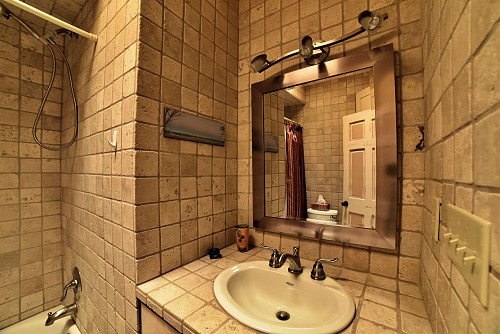Ditra vs. CBU

Tile has, and always will have, two main enemies: movement and water. In the old days (before the 1970s), tile setters routinely defeated the bad guys by laying tile over a thick bed of mortar; mortar isn't damaged by water, so if a crack in a tile or grout line let in water, the tile still stuck. The mortar bed itself was set over tar paper or other "slip sheet" material that let the wood-frame or concrete subfloor move or even crack a little without disrupting the mortar or tile.
This construction is still used today but typically only in custom showers and other high-end, small-scale applications. For the rest of us, the solution to beating the bad guys is tile underlayment. Two common types of underlayment are Ditra, a flexible plastic decoupling membrane (explained later), and cementitious backer units (also known as CBUs, cement board or cement backer board). The question is, which will be a more effective sidekick in your fight to keep your floor tile victorious?
What is Ditra?
A proprietary product created by Schluter Systems, Ditra is a polyethylene decoupling membrane designed to manage movement in wood and many other types of floor systems to prevent cracking and other problems with tile installations. It's also a moisture barrier that suppresses moisture from underneath the tile and, according to the manufacturer, can even help ventilate vapor from wood subflooring to prevent seasonal swelling and thus (you guessed it) movement.
Ditra is 1/8" thick and comes in 39" wide rolls of various lengths. It's installed over a layer of thinset mortar and has a felt backing that creates a mechanical bond with the mortar. Once the Ditra is mortared down, you fill its waffle-like top surface with more mortar, then set the tile on top. We'll spare you the physics lesson here, but essentially the decoupling works because the mortar below the Ditra never bonds to the mortar on top; there's a continuous layer of non-compressible plastic in between. The tile layer is supported by the "column like" (to use the manufacturer's term) structures of mortar filling the waffle cavities.
What's a CBU?
Cement board hit the market as a substitute for drywall in shower installations. On walls, cement board installs much like drywall; it's fastened with screws, then its joints are taped and mudded, except with thinset instead of drywall mud. Unlike drywall, cement board doesn't deteriorate or harbor mold if it gets wet, a common occurrence due to cracks in grout, failed caulk or broken tile. Cement board provides the same protection for floor tile installations. In addition to classic cement board, which is relatively heavy and rough-textured, there are fiber cement products that incorporate cellulose fibers; these are somewhat lighter in weight and smoother-surfaced. Both types come in 1/4" thicknesses (for floors) in a standard panel size of 3 x 5 feet.
On floors, cement board is glued down with thinset and screwed to the subfloor with cement board screws (not regular drywall screws). The joints between panels are taped with alkali-resistant mesh tape and coated with more thinset. Because the panels are taped and mudded, the cement board layer acts somewhat like a monolithic structure and thereby resists movement from the subfloor below. Tile is laid over the cement board with thinset.
What's the Difference Between Ditra and CBUs?
Apart from the material and dimensional differences—one's a 1/8" thick flexible plastic sheet, the other a 1/4" cement-based panel—there are several key design differences between Ditra and cement board.
1. Ditra is waterproof, while cement board lets water through but won't be damaged by it. This may make Ditra a better choice if moisture from below is a concern, such as with some outdoor applications or installations over concrete.
2. Ditra is a decoupler, meaning (in this case) there's no chemical bond between the tile and the subfloor. With cement board, the tile is mortared to the cement board and the cement board is mortared to the substrate, so there's a chemical bond. This difference, Ditra fans would argue, makes it more resistant to movement.
3. Some tile setters also prefer Ditra for its relatively quick installation. You don't have to screw it down, and you can start tiling immediately after the Ditra layer is installed.
4. As a fabric-like material, it's obvious that Ditra offers no additional rigidity to make a floor "stiffer" for tile. Yet, while cement board has some stiffness of its own, it does not add significantly to the overall stiffness of a floor structure. In other words, you can't rely on either material to make a spongy or bouncy subfloor more suitable for tile; you have to add rigidity first, using plywood or other structural panel materials.
5. Finally, there's cost. A 1/4" thick, 3 x 5-foot CBU panel costs about $11, or a little less than $0.75 per square foot. Ditra costs about $1.50 per square foot. Ditra requires more mortar overall and you have to buy the manufacturer's special tape if you want to create a moisture barrier. CBUs need screws and joint tape. For a standard-size tile job, the difference in cost shouldn't be a deal-breaker.
Contact a professional tile installer and see what he has to say.
Updated December 21, 2017.
Looking for a Pro? Call us (866) 441-6648

Tile Contractors Experiences

Outstanding Tile Installation Based On My Own Design

Tile Installation For New Kitchen Backsplash And Guest Bathroom Floor



